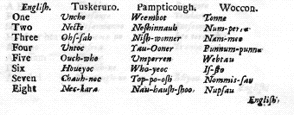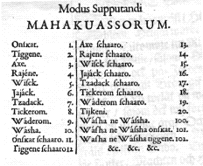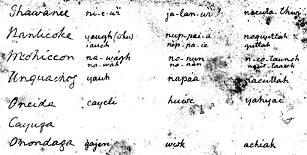
Evolution
PO Box 1333
Merchantville NJ 08109, USA
Email: info@arxpub.com
 Evolution |
Evolution Publishing PO Box 1333 Merchantville NJ 08109, USA Email: info@arxpub.com |
|
|
|
||
During the early history of the American nation, a number of explorers, scholars and missionaries sought to record the languages of the native peoples they encountered. As many of the native American tribes dwindled into extinction, the need became all the more pressing to preserve their languages for posterity, and Americans who were keenly anxious to promote their country's heritage went through great pains to make sure that the ancient tongues of the American landscape would not pass into obscurity unrecorded.
 |
|
|
They were right to be concerned, for although many languages of the interior of our nation have survived the journey into the age of audio recording, those of the East Coast generally have not. For many languages of the Eastern Woodlands whose living memory is long vanished, the only testaments are those vocabularies, word-lists and dictionaries which were collected long ago. They were not all scientifically-trained linguists, these collectors. Many were explorers or settlers who understood only the barest basics of what was necessary for treaties and trading, and their ears often failed to detect the grammatical subtleties of the idioms they recorded. Many of these testaments are also frustratingly brief, with sometimes as little as a few dozen words.
But despite all the shortcomings of these sources, they are often the only windows we have into the nature of these ancient languages, from which time has separated us forever. And as such, they deserve a position of honor in the annals of American philology, as the bridges between the present nation we are and the ancient nation we once were.
Yet, their obvious importance notwithstanding, these vocabularies are often barely accessible. Some are preserved only in manuscript, rare and valuable pages tucked away in the vaults of research institutions. Others were fortunate enough to be published in the last three centuries; but some of the publications which contained them are now antiques in their own right, and consequently have become very difficult to find themselves. Sparse linguistic fragments are also scattered throughout the literature and suffer from never having placed in their proper context.
Other published reprints in historical Native American linguistics have tended to ignore the smaller vocabularies in favor of the larger dictionaries. But such large works are only available for a scant few languages, leaving the vast majority of small yet important works still unaccounted for. With the publication of the ALR series, which began in 1996, a new chapter in the history of these extraordinary sources is being written.
The ALR series was conceived expressly for the preservation and
promotion of these shorter linguistic records, vocabularies of only a
few hundred entries or less. These vocabularies are crucial in filling
in the vast linguistic gaps that the larger works leave empty. They
cover a whole host of Eastern Woodlands languages that were never
thoroughly documented, and they are also particularly useful in
preserving regional dialects
and archaic versions of languages that are otherwise well attested.
The Goals of the ALR
 |
|
Susquehannock, printed in Sweden in 1696 |
Our goals are two-fold for each new volume in the series. First, we insist on accurate transcription of the original work. The vocabularies which make up the volumes of the series are carefully re-transcribed: while the English is modernized as needed, the entries in the native language are preserved *exactly* as they appear, including all accents and foreign or invented characters which are used by the original authors. Multiple spellings and extra terms are sometimes given, when two or more editions differ.
Our second goal is to make these vocabularies reference-friendly and accessible for scholars and non-scholars alike. Most of the vocabularies as originally printed were unidirectional and non-alphabetical, making them difficult to consult effectively. The ALR entries are fully alphabetized and listed bidirectionally: Language-English and English-Language, with additional sections for phrases and numerical tables.
This bidirectional arrangement is particularly convenient for
scholars doing comparative studies, since it greatly simplifies the
process
of finding cognates. English equivalents are always at your fingertips
so that, for instance, commonly preserved words such as "fire" can be
looked up at a glance. Alternatively, scholars can browse the
alphabetically-listed headwords in the native language to identify
prefixes and common roots.
Sources selected
The ALR series brings together a number of vocabularies which typically number between 100-500 entries; some with editorial commentaries by the foremost American linguists of the last century, such as Peter Duponceau, Daniel Brinton and J. Dyneley Prince. We are also making available rare and unique word-lists of less than one hundred entries, in languages or dialects that were never properly recorded such as Pamunkey, Sanhican, and Assateague. These are appended onto the larger vocabularies, grouped together by geography and linguistic affiliation where possible.
 |
|
of Thomas Jefferson: the numbers from four to six are shown. |
The series' initial focus is on the languages of the Northeastern
coast, with heaviest emphasis on the Eastern Algonquian and Iroquoian
families. These were among the first to come in prolonged contact with
European settlers, and as a result were among the first to be displaced
and
eventually perish. Dates of the ALR sources vary considerably. Some
date
from the 1500's and 1600's; taken down by the first explorers, settlers
and missionaries to reach these shores. In the 1700's interest in
native
languages began in earnest, and much of what is preserved today is the
direct result of no less a national figure than Thomas Jefferson who
took
an active role in documenting them. By the 1800's into the early part
of
this century, the true golden era of American philology had come into
being,
and eminent scholars were devoting their energies to full grammatical
descriptions and classification, laying the solid groundwork upon which
modern scholarship rests.
Physical characteristics
Since the ALR series was designed specifically for academic institutions and libraries, a great deal of care was placed in design and binding. Each volume is bound in durable hardcover, using Davey(tm) acid-free binders board and moisture-resistant B-grade library book cloth. Printing is done on acid-free paper to ensure longevity. The signatures are center-stitched, not glued, so that each book opens flat and the pages will never fall out. For ease of cataloging and shelving, we participate in the Library of Congress' Cataloging-in-Publication (CIP) program.